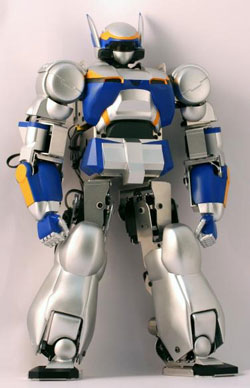Jul 17 2006
Using research results from the Humanoid Research Group of the Intelligent Systems Research Institute of AIST, two start-up companies approved by AIST, i.e., General Robotix, Inc and Moving Eye, Inc., working together with Pirkus Robotix, Inc. and Dai Nippon Technical Research Institute, have developed a humanoid robot called "HRP-2m Choromet," or "Choromet," for short.

Chromet is 35 cm high, weighs 1.5 kg, and has 20 degrees of freedom. It has triaxial force/torque sensors on its legs and accelerometer and gyroscope on its trunk, and a small, energy-saving controller developed at AIST that is driven in real-time by Linux (ARTLinux). Also developed at the same time at AIST was base software that runs on the Linux system. Moving Eye (ME) had already been working on the miniature controller and ARTLinux, while General Robotix (GRX) had already been working on the base software for the robot. Chromet is the result of combining these technologies. Given these traits, the software used to move and control Chromet may have applications in education and research.
The robot in this project was developed by high-tech start-up and other companies with technology that had been transferred from AIST. This is an excellent example of AIST's function as a hub for innovation.
Background of the Development
In recent years, there has been much progress in the development of humanoid robots such as the Honda Motor Company's ASIMO. Most of small humanoid robots have been made for hobbyists, and sales of some have reached in the thousands. However, these hobby robots have run based on direct instructions or GUI, and almost none of them can be programmed using software, so they are not suitable for educational and research applications.
History of the Development
AIST has so far developed the humanoid robot HRP-2 Promet and fundamental technologies for humanoid robots such as the software platform OpenHRP. AIST has also developed ARTLinux (developed by Yoichi Ishiwata, currently CTO of ME) which has achieved real-time processing in the user space, and the small energy-saving controller into which ARTLinux is loaded. These results have been put to practical use by GRX and ME, two start-up companies working with AIST.
HRP-2 Promet has been used in R&D organizations such as universities as a research and development platform. Unfortunately, the very high unit price of tens of millions of yen is impeding its widespread use. The present work was undertaken to enable the use of high-level research results like OpenHRP and ARTLinux to be used with low-cost robots.
Details of the Development
Choromet was developed to be small and inexpensive. For this reason, it uses a servomotor for hobby robots. Moreover, its link structure allows it to be made with metal plates, but it was designed so that there would be as little offset as possible in the joint axes. The rigidity of this robot has reached the level where the effectiveness of its motion patterns can be tested at the same level as movement patterns for humanoid robots.
In the above sectors, there have been development results for small, two-legged robots at Pirkus. Under the supervision of Jin Sato, Pirkus is in charge of designing mechanical links, which is its specialty.
The controller, a small (business card-sized) energy-saving controller (SH-4 240 MHz, 32M) developed by AIST, has been given a new serial interface which provides input and output with the servomotor, sensors, and so on. In charge of this development is ME, which has been working on practical use of ARTLinux.
This controller features some of the functions of the humanoid robot software platform OpenHRP, which has helped give the robot movements such as walking on two legs and getting up. The creation of movement patterns based in part on ZMP and the control of sensor feedback has allowed the new robot to walk with smaller feet than conventional hobby robots. The above development is being handled by GRX.
The exterior of the robot was designed to not restrict the range of movement of the joints, to be as safe as possible, and to approximate HRP-2 Promet. The overall design was supervised by Yutaka Izubuchi, who was also in charge of the design for HRP-2 Promet. The development of the plastic model, robot exterior, etc., was undertaken by Dai Nippon Technical Research Institute.
In summary, it has become possible to run Choromet on a software-based movement program on a real-time Linux platform, which has reached the level where the effectiveness of the humanoid robot motion patterns can be corroborated.
Future Plans
Plans call for corroboration tests to be conducted using this prototype robot, evaluations to be made of its mechanical rigidity, the minimum required sensors be selected, and necessary changes be made in order to market this as a low-cost platform for education and research. Plans also call for the creation of a simulator for Choromet and the development of contents for educational uses.
The prototype robot was exhibited at the Robotics and Mechatronics Symposium of the Japan Society of Mechanical Engineers held on May 27-28, 2006 at the Okubo campus of Department of Science and Technology, the Waseda University.
Key Points
- Four private companies, including 2 start-up companies approved by AIST, have jointly developed a humanoid robot.
- The robot comes with base software developed by AIST and runs on real-time Linux.
- The new robot may have applications in education and research.
http://www.aist.go.jp